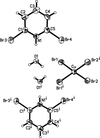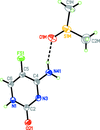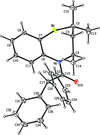issue contents
November 2009 issue

Cover illustration: The structure of one of the two independent molecules of 3,3,6,6,9,9-hexaethyl-1,2,4,5,7,8-hexaoxacyclononane (DEKTP). Displacement ellipsoids are drawn at the 30% probability level and H atoms are shown as small spheres of arbitrary radii. See Cerna, Bernès, Cañizo & Eyler [Acta Cryst. (2009), C65, o562-o564].
inorganic compounds
Download citation


Download citation


The crystal structure of the Sb-rich variety of the mineral gustavite, AgPb(Bi2Sb)3S6, a naturally occuring monoclinic lillianite homologue with N = 4, has been solved and refined for the first time by means of single-crystal X-ray diffraction. The crystal structure consists of blocks of diagonal chains of four octahedra, viz. M1a (Bi), M2a (Sb/Bi), M2b (Bi/Sb) and M1b (Ag), separated by Pb atoms in a trigonal prismatic coordination.
Download citation


Download citation


The crystal structure of sodium magnesium sulfate decahydrate was solved and refined for the first time. Alternating layers of [Mg(H2O)6]2+ and [Na2(SO4)2(H2O)4]2− ions, parallel to [100], are held together by hydrogen bonding.
Download citation


Download citation


A new polymorph of nonacopper(II) bis(orthoborate) bis(hexaoxodiborate), Cu9(BO3)2(B2O6)2, or Cu3B2O6 with Z′ = 3, has a pseudo-layered monoclinic structure containing BO3 triangles and B2O6 units consisting of corner-sharing BO3 triangles and BO4 tetrahedra. The compound was obtained during an investigation of the Li–Cu–B–O system. In contrast to the triclinic form of Cu3B2O6, the layers are linked to one another by BO4 tetrahedra.
metal-organic compounds
Download citation


Download citation


Download citation


Download citation


Download citation


Download citation


Download citation


Download citation


Download citation


Download citation


Download citation


Download citation


Download citation


Download citation


Download citation


Download citation


Download citation


Download citation


Download citation


Download citation


Download citation


Download citation


organic compounds
Download citation


Download citation


Download citation


Download citation


Download citation


Download citation


Download citation


Download citation


Download citation


Download citation


Download citation


Download citation


Download citation


Download citation


Download citation


Download citation


Download citation


Download citation


Download citation


Download citation


Download citation


Download citation




 journal menu
journal menu










































